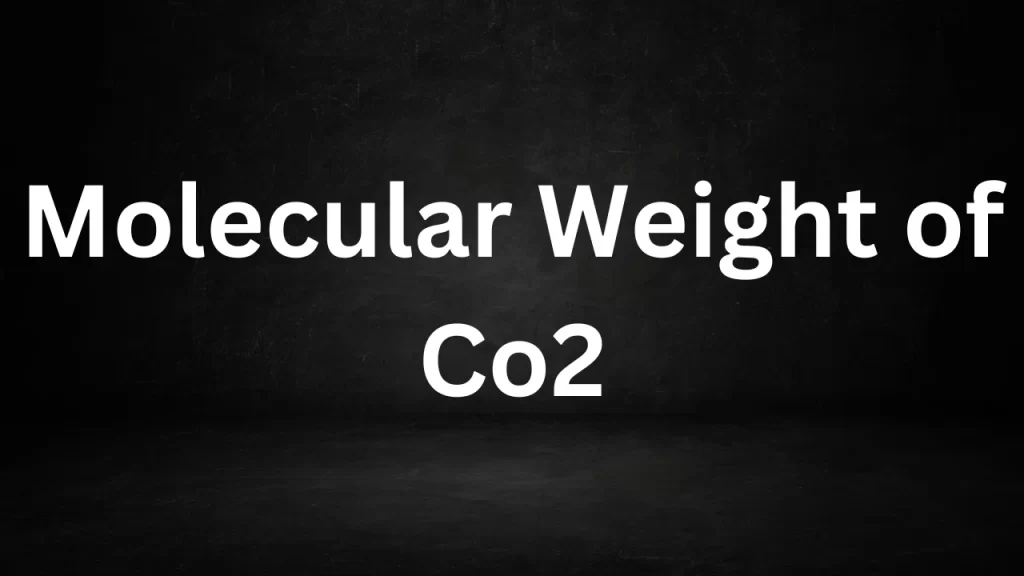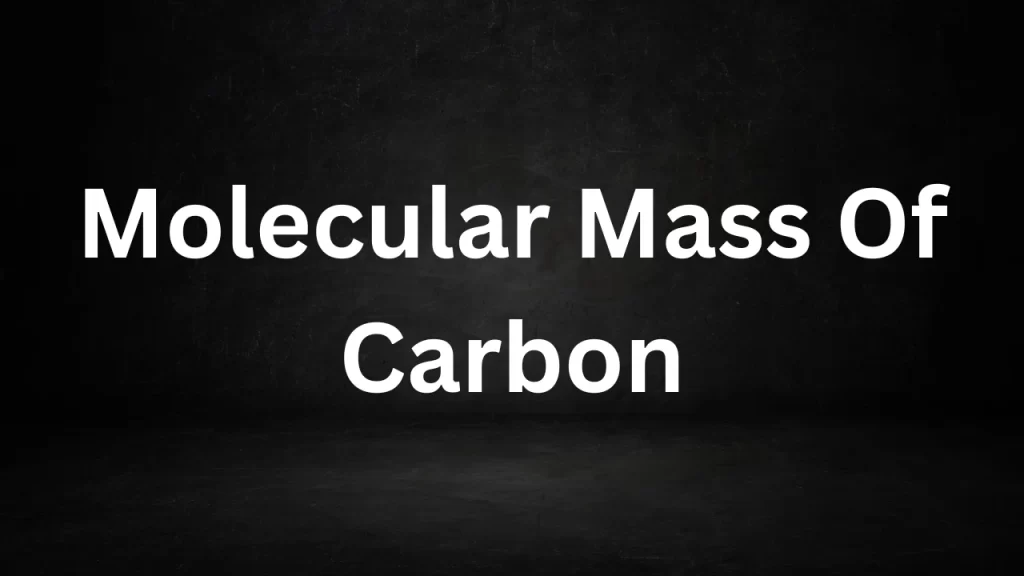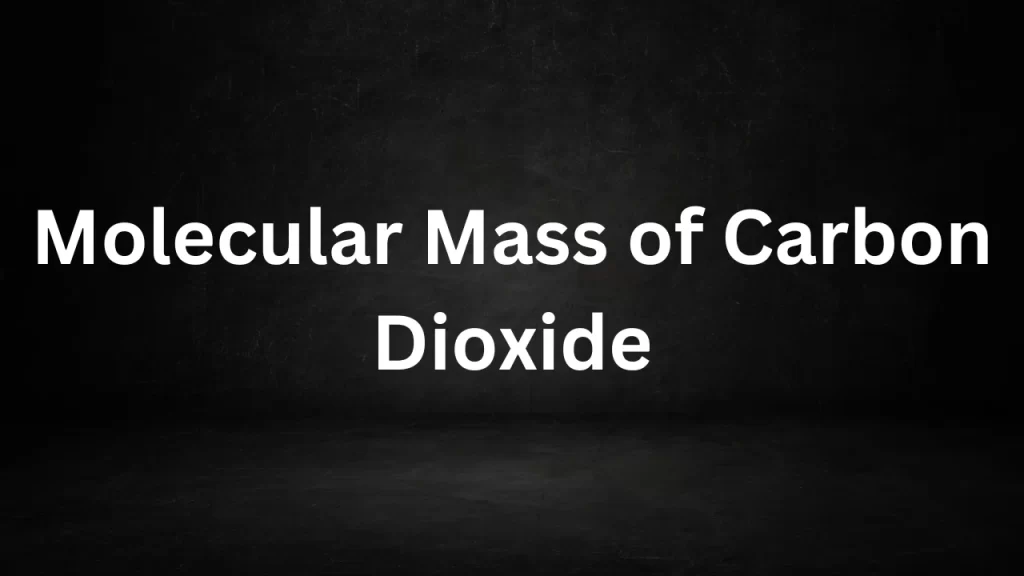Tag: molecular weight for co2
Molecular Mass of Carbon Dioxide
Molecular Mass of Carbon Dioxide: Carbon dioxide (CO2) is a molecule that plays a significant role in our environment and in various industrial processes.
To comprehend its behavior and its importance in chemistry, it is essential to understand its molecular mass. In this article, we will delve into the concept of mole mass and explore the mole mass of carbon dioxide.
Molecular Mass of Carbon Dioxide
The Chemical Formula of Carbon Dioxide
The chemical formula of carbon dioxide is CO2, which signifies that one molecule of carbon dioxide consists of one carbon (C) atom and two oxygen (O) atoms.
Calculating the Molecular Mass of Carbon Dioxide
To calculate the mole mass of carbon dioxide, we need to consider the atomic masses of its constituent elements:
- Carbon (C) has an atomic mass of approximately 12.01 amu.
- Oxygen (O) has an atomic mass of approximately 16.00 amu.
Now, let’s calculate the mole mass of carbon dioxide:
mole Mass of Carbon Dioxide (CO2) = (1 x Atomic Mass of Carbon) + (2 x Atomic Mass of Oxygen) mole Mass of Carbon Dioxide = (1 x 12.01 amu) + (2 x 16.00 amu) mole Mass of Carbon Dioxide ≈ 44.01 amu
Significance of Molecular Mass in Chemistry
The mole mass of a substance is crucial for various chemical calculations, including:
- Stoichiometry: It helps in determining the quantities of reactants and products in chemical reactions.
- Mole-to-Mass Conversions: It allows converting between moles and mass, which is essential for laboratory work and chemical synthesis.
- Gas Laws: It is used in gas law equations to relate the properties of gases to their molecular masses.
Conclusion
The mole mass of carbon dioxide, approximately 44.01 atomic mass units (amu), is a fundamental parameter in understanding its properties and its role in various chemical reactions and environmental processes. Whether studying its behavior in chemical reactions or assessing its impact on the Earth’s atmosphere, knowing the mole mass of carbon dioxide is essential for a thorough understanding of its significance in chemistry and beyond.
Read More
- Difference Between Conduction Convection And Radiation
- Excretory System Class 10
- Sodium Carbonate Molar Mass
- Layers Of The Earth
- Environmental Pollution And Recycle
Frequently Asked Questions (FAQs) On Molecular Mass of Carbon Dioxide
1. What is the molecular mass of carbon dioxide?
The mole mass of carbon dioxide (CO2) is approximately 44.01 atomic mass units (amu) or unified atomic mass units (u).
2. How is molecular mass different from molar mass?
mole mass refers to the mass of a single molecule, while molar mass is the mass of one mole of a substance. For carbon dioxide, the molar mass is 44.01 grams per mole (g/mol).
3. What is the chemical formula of carbon dioxide?
The chemical formula of carbon dioxide is CO2, indicating that one molecule of carbon dioxide consists of one carbon (C) atom and two oxygen (O) atoms.
4. How is the molecular mass of carbon dioxide calculated?
To calculate the mole mass of carbon dioxide, you add the atomic masses of its constituent elements: one carbon atom and two oxygen atoms.
5. Why is knowing the molecular mass of carbon dioxide important in chemistry?
Understanding the mole mass of carbon dioxide is crucial for various chemical calculations, such as stoichiometry, mole-to-mass conversions, and its relevance in gas laws.
Molecular Weight of Co2
Molecular Weight of Co2: Carbon dioxide (CO2) is a chemical compound that plays a significant role in various natural processes, climate change, and industrial applications.
Understanding its molecular weight is crucial in chemistry, environmental science, and engineering. In this article, we will explore the molecular weight of CO2, its composition, and its relevance in different fields.

mol Weight of Co2
mol Composition of CO2
Carbon dioxide (CO2) is composed of one carbon atom (C) and two oxygen atoms (O), bonded together through covalent bonds. Its chemical formula, CO2, reflects this composition, indicating one carbon atom and two oxygen atoms in a single molecule.
mol Weight of CO2
The mol weight of a substance is calculated by adding the atomic weights of all the atoms in its chemical formula. To determine the mol weight of CO2, we consider the atomic weights of carbon (C) and oxygen (O):
- The atomic weight of carbon (C) is approximately 12 atomic mass units (amu).
- The atomic weight of oxygen (O) is approximately 16 amu.
Now, let’s calculate the mol weight of CO2:
mol Weight of CO2 = (Atomic Weight of C) + 2 × (Atomic Weight of O) mol Weight of CO2 = 12 amu + 2 × 16 amu Molecular Weight of CO2 = 12 amu + 32 amu Molecular Weight of CO2 = 44 amu
Therefore, the mol weight of carbon dioxide (CO2) is 44 atomic mass units (amu).
Significance of the mol Weight of CO2
The mol weight of CO2 holds significant importance across various scientific disciplines:
1. Chemistry:
In chemistry, the mol weight of CO2 is essential for stoichiometry, which involves the calculation of reactant and product quantities in chemical reactions. It helps determine the balanced chemical equations and the molar relationships between substances in a reaction.
2. Environmental Science:
Understanding the mol weight of CO2 is vital in environmental science and climate change research. CO2 is a greenhouse gas, and its molecular weight influences its behavior in the atmosphere, including its role in trapping heat and contributing to global warming.
3. Industry and Engineering:
In industrial processes, the molecular weight of CO2 is relevant for designing equipment, such as compressors and separators, used in the extraction, storage, and transport of carbon dioxide. It is also crucial in carbon capture and storage (CCS) technologies.
4. Health and Safety:
In safety assessments and industrial hygiene, the molecular weight of CO2 is considered when evaluating its effects on human health. High concentrations of CO2 can be hazardous, affecting respiration and leading to asphyxiation.
5. Education and Research:
The mol weight of CO2 is a fundamental concept taught in chemistry and science education. It forms the basis for understanding chemical reactions, gas properties, and environmental issues.
Conclusion
The mol weight of carbon dioxide (CO2), calculated as 44 atomic mass units (amu), is a critical parameter with broad implications in chemistry, environmental science, industry, and safety. It governs the behavior of CO2 in various contexts, from chemical reactions to its role as a greenhouse gas. As we continue to grapple with climate change and environmental challenges, a deep understanding of CO2’s molecular weight remains indispensable in addressing these global issues.
Read More
- Molecular Mass of Water
- Difference Between Cyclone And Hurricane
- Molecular Weight Of Na
- Molecular Mass Of O2
- Molecular Mass of H2
Frequently Asked Questions (FAQs) Molecular Weight of Co2
Q1: What is the mol weight of CO2 (carbon dioxide)?
A1: The mol weight of carbon dioxide (CO2) is 44 atomic mass units (amu). This value is calculated by adding the atomic weights of one carbon atom (approximately 12 amu) and two oxygen atoms (approximately 16 amu each) in a CO2 molecule.
Q2: Why is knowing the mol weight of CO2 important?
A2: Understanding the mol weight of CO2 is important in various fields. In chemistry, it’s essential for stoichiometry and reaction calculations. In environmental science, it’s crucial for studying climate change and greenhouse gas emissions. It also has significance in industrial processes, safety assessments, and education.
Q3: How is the molecular weight of CO2 used in stoichiometry?
A3: In stoichiometry, the molecular weight of CO2 is used to calculate the molar relationships between substances in a chemical reaction. It helps determine the balanced chemical equations and allows for the calculation of reactant and product quantities.
Q4: What is the role of CO2’s mol weight in climate change research?
A4: CO2’s mol weight plays a role in climate change research because it influences how CO2 behaves in the atmosphere. CO2 is a greenhouse gas, and its molecular weight affects its ability to trap heat, contributing to global warming and climate change.
Q5: How is the mol weight of CO2 relevant in industry and engineering?
A5: In industry and engineering, the mol weight of CO2 is relevant for designing equipment used in processes involving CO2, such as compressors and separators. It’s also crucial in carbon capture and storage (CCS) technologies, which aim to mitigate CO2 emissions from industrial sources.
Molecular Mass of Water
Difference Between Cyclone And Hurricane
The Molecular Weight Of Na
Molecular Mass Of O2
Molecular Mass of H2
Molecular Mass Of Carbon
Molecular Mass Of Carbon: Carbon, often referred to as the “element of life,” is a cornerstone of organic chemistry and the very foundation of life on Earth.
In this article, we will explore the molecular mass of carbon (C), its significance in the world of chemistry, and its vital role in various aspects of science and everyday life.

Molecular Mass Of Carbon
The Significance of Carbon
Carbon is the fourth-most abundant element in the universe by mass and the sixth-most abundant element in the human body by atomic count. Its unique ability to form stable covalent bonds with other carbon atoms and a wide variety of other elements makes it the central building block for organic compounds. Carbon compounds are the basis of life as we know it, forming the structure of DNA, proteins, carbohydrates, and countless other biomolecules. Carbon is also essential in industry, with applications ranging from energy production to materials science and beyond.
Atomic Structure of Carbon
Carbon, with the atomic number 6, has a relatively simple atomic structure. A carbon atom consists of six protons and six neutrons in its nucleus, surrounded by six electrons distributed in two energy levels or electron shells. The electron configuration of carbon is 1s² 2s² 2p², indicating that it has two electrons in the first shell and four in the second shell. The outermost shell, with its four electrons, is known as the valence shell.
Molecular Mass of Carbon
The molecular mass of an element, also known as its molar mass, is defined as the mass of one mole of atoms of that element, measured in grams per mole (g/mol). To calculate the molecular mass of carbon (C), we simply consider the atomic mass of a single carbon atom:
Carbon (C) has an atomic mass of approximately 12.01 g/mol.
Therefore, the molecular mass of carbon is approximately 12.01 grams per mole.
Significance of Molecular Mass in Chemistry
Understanding the molecular mass of carbon is fundamental in chemistry. It serves as a reference point for determining the masses of molecules and compounds that contain carbon atoms. Chemists use this value extensively in stoichiometry, chemical calculations, and the formulation of chemical equations. Additionally, it plays a crucial role in the field of analytical chemistry, where precise measurements of molecular mass are essential for identifying and quantifying compounds.
Conclusion
The molecular mass of carbon, approximately 12.01 g/mol, is a fundamental constant in the realm of chemistry and science at large. It underscores carbon’s significance as the backbone of life on Earth, the building block of organic compounds, and a key element in countless industrial applications. Whether you’re exploring the intricacies of molecular biology, the chemistry of materials, or the energy technologies of the future, a solid grasp of carbon’s molecular mass is indispensable for advancing scientific knowledge and innovation.
Read More
- Molar Mass Of Phosphorus
- Molar Mass of Chlorine
- Electrical Energy And Power
- Dynamics Of Circular Motion
- Molecular Weight Of Acetic Acid
Frequently Asked Questions (FAQs) Molecular Mass Of Carbon
Q1: What is the molecular mass of carbon?
A1: The molecular mass of carbon (C) is approximately 12.01 grams per mole (g/mol).
Q2: Why is the molecular mass of carbon important in chemistry?
A2: The molecular mass of carbon is crucial because it serves as a reference point for determining the masses of molecules and compounds that contain carbon atoms. It plays a fundamental role in stoichiometry, chemical calculations, and the formulation of chemical equations.
Q3: What are some common compounds and molecules that contain carbon?
A3: Carbon is a fundamental element in organic chemistry, and it forms the basis of various compounds and molecules, including:
- Hydrocarbons: Compounds consisting of carbon and hydrogen, such as methane (CH4) and ethane (C2H6).
- Carbohydrates: Sugars, starches, and cellulose, which are essential for energy storage and structural support in living organisms.
- Proteins: Complex biomolecules composed of amino acids, each containing carbon.
- Lipids: Organic molecules like fats and oils that contain carbon and hydrogen.
- Nucleic acids: DNA and RNA, which store genetic information, are composed of carbon, hydrogen, oxygen, nitrogen, and phosphorus.
Q4: How is the mol mass of carbon calculated?
A4: The mol mass of carbon is calculated based on the atomic mass of a single carbon atom. Carbon has an atomic mass of approximately 12.01 g/mol, which is used to determine its mol mass.
Q5: Is carbon unique in its ability to form a wide variety of compounds?
A5: Yes, carbon is unique in its ability to form stable covalent bonds with other carbon atoms and a diverse range of other elements. This versatility allows it to create a vast array of organic compounds, contributing to the complexity and diversity of life and the world of chemistry.
